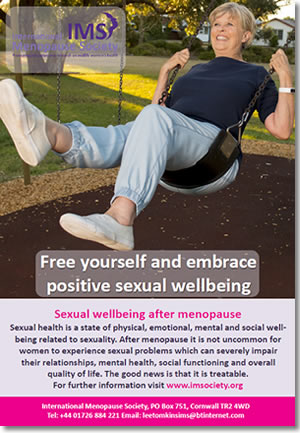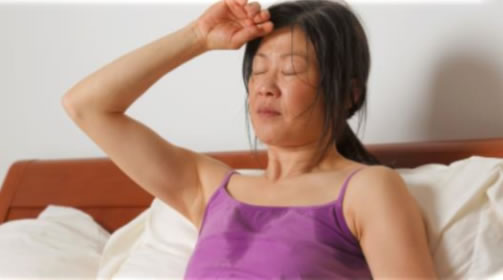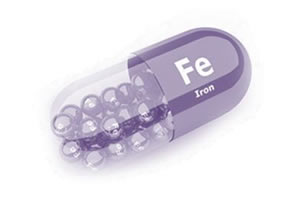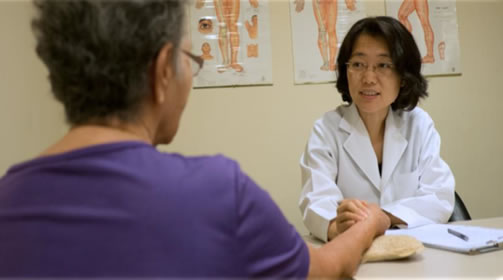Being positive about sexual wellbeing after menopause
 Free yourself and embrace positive sexual wellbeing
Free yourself and embrace positive sexual wellbeing
Download booklet here: ![]() Sexual wellbeing after menopause840.7 KB
Sexual wellbeing after menopause840.7 KB
Sexual wellbeing
Sexual health is a state of physical, emotional, mental and social wellbeing related to sexuality.
Sexuality is an integral part of the human psyche. Sexuality is expressed throughout life in all people both consciously and unconsciously in body movements and body language, speech, appearance and in every imaginable way people interact with each other. The way people demonstrate their innate sexuality varies according to their stage of life. Sexuality is not limited by age, relationship status or sexual preference.
Studies across a number of countries have shown that women place high value on sexual intimacy in their relationships and the majority of women continue to be sexually active into their later years. [1., 2.]
Consequently, a decrease in sexual wellbeing and loss of intimacy can have profoundly negative effects. After menopause 30-50% of women experience sexual difficulties that adversely impact their intimate relationship, psychological wellbeing health, social functioning and overall quality of life. [3., 4.] However, there is a range of treatment options for women to consider.
Menopause and sexual function
Menopause is the end a woman’s reproductive years and when the ovaries no longer go through a monthly cycle. The ovaries effectively “run out of eggs” and produce little oestrogen. This depletion in oestrogen can lead to several changes in your body. The most commonly talked about symptoms are hot flushes and night sweats. But in addition, the fall in oestrogen causes vaginal dryness, making sexual intercourse uncomfortable or painful. Women also might experience lowered mood and /or anxiety, difficulty sleeping and a change in their body shape. All of these can contribute to a decrease in sexual wellbeing.
Sexual activity tends to lessen with ageing in terms of frequency, but women do not suddenly stop being sexual when they reach menopause. Older women experience fewer sexual thoughts and fantasies, lessened vaginal lubrication with intercourse, and less sexual satisfaction. For many women these changes are subtle and do not interfere with their overall sexual relationships.
The most commonly reported sexual problems experienced by women after menopause relate to sexual desire and interest, pleasure and overall satisfaction. Vaginal dryness and discomfort with intercourse are also common problems. Sometimes loss of libido and arousal is simply explained by the hormonal changes. But at midlife, as at any life phase, other factors such as poor self-image, family responsibilities, less opportunity for privacy, and partner health affect sexual wellbeing.
 75% of women experience hot flushes and night sweats as a result of menopause. You might find that being physically close to your partner triggers a flush or you might feel less sexually attractive having a hot flush. With tremendous social emphasis on youthfulness, it is hard not to be self-conscious of bodily signs of aging such your breasts being less full, or a few more wrinkles. In
75% of women experience hot flushes and night sweats as a result of menopause. You might find that being physically close to your partner triggers a flush or you might feel less sexually attractive having a hot flush. With tremendous social emphasis on youthfulness, it is hard not to be self-conscious of bodily signs of aging such your breasts being less full, or a few more wrinkles. In
addition, weight gain is common at midlife. Overall weight gain is not linked to menopause but reflects either decreased activity or increased calorie intake, or both.
However, lack of oestrogen causes increased tummy fat, which in turn tends to make women feel less sexually attractive.
Testosterone is often talked about in the context of sexual wellbeing. Testosterone is an important female hormone. Whereas oestrogen levels fall at menopause, testosterone begins to decline when women are in their late 30s-40s, and falls slowly with age. This age-related fall in testosterone can contribute to lessened sexual interest in women at midlife. Nonetheless, the greatest predictor of a satisfying sexual relationship/experiences after menopause is the quality of a women’s sexual life before menopause, with those most satisfied with this aspect of their life just before menopause being least likely to have problems. The availability of an interested partner and the health of the partner are important components of sexual wellbeing for most women.
When a sexual symptom, such as low desire, inability to become aroused or inability to experience an orgasm is both persistent and causes significant personal distress it is classified as a sexual dysfunction. If you are experiencing a sexual symptom that causes you significant worry or distress, then you should speak with your doctor and explore potential causes and treatment options.
Sexual problems experienced by women include:
- Low interest or motivation to engage in sexual activity (low libido),
- Lessened ability to become aroused or experience vaginal lubrication (wetness)
- Difficulty achieving /or absent orgasm, and/or
- Painful intercourse (dyspareunia).
In the context of a sexual relationship these problems are often associated with a decrease in the frequency and pleasure of sexual activity and can become a source of tension and distress for the affected woman and her partner.
Vaginal discomfort and sexual function
Vaginal discomfort and/or dryness during intercourse after menopause is primarily a result of oestrogen insufficiency. The inner wall of the vagina becomes thinner and less elastic, and less able to produce secretions that cause lubrication during sexual arousal. [5.] Other common symptoms include vaginal itching and irritation [6.] . There is a gradual change in the fullness of the labia (lips pf the vagina) due to loss of fat
tissue. Although the clitoris tends to become smaller with age, the response to stimulation remains intact, but women may find that it takes longer to achieve a sexual plateau. Approximately 50% of postmenopausal women have vaginal symptoms that contribute to lowered sex drive, poor arousal and orgasm, and reduced sexual satisfaction) [7.]. The good news is that treatment of vaginal symptoms is usually straightforward.
What else may cause sexual dysfunction?
 Female sexual dysfunction does not have to be triggered by the menopause. Other causes of sexual dysfunction include poor physical or psychological health, a poor relationship, previous negative sexual experiences, side effects of common medications and negative pressure from cultural and social values.
Female sexual dysfunction does not have to be triggered by the menopause. Other causes of sexual dysfunction include poor physical or psychological health, a poor relationship, previous negative sexual experiences, side effects of common medications and negative pressure from cultural and social values.
Psychological wellbeing
Feelings and emotions of each partner in a relationship partners are strong predictors of sexual health.
Although loss of sexual desire increases with age, partnered postmenopausal women are more likely to experience low desire with associated distress than non-partnered women [8., 9.].
Depression and anxiety and antidepressant/antianxiety medications can cause loss of sexual desire, lack of arousal and inability to achieve orgasm. The depression and/or anxiety may be associated with menopause, and /or other environmental factors such as work or family stress. Past physical, emotional or sexual abuse will affect sexual wellbeing. When psychological influences underpin sexual dysfunction, improvement is unlikely without supportive counselling. [10., 11.]
Physical wellbeing
Any cause of poor physical health can impair sexual wellbeing. Two common health conditions that emerge at midlife and affect sexual wellbeing include urinary incontinence and pelvic organ prolapse. You should speak with your doctor if you have symptoms of urinary leakage (incontinence) or a sense of a vaginal bulge.
Physically coitus is about as strenuous as a vigorous walk. For women with heart disease sexual activity is usually safe if there is no difficulty climbing a flight of stairs or walking briskly for 10–15 minutes without any distress.
Diabetes can be a cause of sexual dysfunction due to diabetes causing impaired genital sensation, reduced vaginal blood flow and recurrent urinary tract and vaginal infections, such as thrush. For women with diabetes emptying the bladder before and soon after intercourse is advised to reduce the risk of such infections.
Medications prescribed for various diseases can potentially affect female sexual function, but unfortunately have not been well studied in women, as opposed to the vast literature on drug induced impotence in men. If you suspect your medication is affecting your sexual function, speak to your doctor about this.
Sexual dysfunction after breast, gynaecological and other cancers is common, but fortunately this is an issue that is being more openly discussed. Many national cancer support groups have information available for women after a diagnosis of cancer.
 Things to consider if you are experiencing poor sexual wellbeing:
Things to consider if you are experiencing poor sexual wellbeing:
- Is this causing you personal distress and pressure on your relationship?
- How long has this been going on?
- When do you last feel sexual satisfaction?
- Are you having bothersome menopausal symptoms?
- Are you experiencing vaginal dryness /soreness?
- What other things have been happening in your life, your relationship or your health that might be contributing lowered sexual wellbeing?
- Are you experiencing lowered mood/depression?
- Could you be iron deficient and therefore just very tired?
Treatments available
There are various treatments available for women with sexual difficulties, but the effectiveness of treatments varies between women. It is important to seek advice, because without some form of treatment, symptoms
are unlikely to diminish or go away on their own [12.]. Addressing your sexual difficulties and striving for positive sexual wellbeing can enhance the quality of your relationship, improve your psychological wellbeing and enhances your overall quality of life.
Sexual counselling
It is important to include your partner. Not discussing sexual problems or the emotional impact it is having on you, can result in shutting your partner out and could potentially cause relationship break down. [13., 14.] Attending sexual counselling with your partner can allow you both to become aware of each other’s needs and discover sexual options which may be more comfortable (psychologically and physically). Discussing the problem is the first step towards gaining answers to develop a healthier relationship. [15.]. Most couples who have used sexual counselling together have found that it improved their sex life. [16.].
 Depending on the sexual problem, psychotherapy may be used alone or in conjunction with medical treatments. Even when the cause of a sexual problem is medical, cognitive behavioral therapy (CBT) can help improve symptoms. [17.].
Depending on the sexual problem, psychotherapy may be used alone or in conjunction with medical treatments. Even when the cause of a sexual problem is medical, cognitive behavioral therapy (CBT) can help improve symptoms. [17.].
Psychotherapy may be sufficient for some but not for others. Mindfulness-based cognitive behavioral sex therapy (MBCST) has demonstrated to be effective for improving desire. [18., 19.].
Combining medical treatments and psychotherapy when treating a sexual problem is often considered, since more than one factor may be contributing to it. [20.]
Managing vaginal discomfort
Vaginal oestrogen, as a cream or small tablet inserted into the vaginal 2-3 times a week, is highly effective for the treatment of vaginal symptoms, as well as inexpensive and safe. Other options in some countries include daily vaginal DHEA cream and a tablet called ospemifene. Discuss these treatment options with your doctor. For women who cannot use vaginal oestrogen, for example after a diagnosis of breast cancer, vaginal moisturisers can relieve symptoms when used regularly. Vaginal lubricants bought over the counter provide moisturisation during sexual activity. Vaginal lubricants need to be used at or near the time of sexual activity because they have a temporary effect.
Vaginal laser therapy is being increasingly offered. Although vaginal laser therapy has been reported to be effective, more studies are needed to establish effectiveness and long-term safety of this treatment.
Managing menopausal symptoms
Speak to your doctor about what you can do about bothersome menopausal symptoms, particularly flushes and sweats causing sleep deprivation, and recent onset anxiety and low mood. These symptoms affect overall wellbeing and interest in sex. Menopausal hormone therapy (MHT) is available in a number of different doses and formulations (such as patches, tablets, creams and gels) and for many women the benefits outweigh the risks. [7.].
Testosterone, at a dose appropriate for women, can improve sexual well-being in postmenopausal women with low sexual desire associated with distress [21., 22.]. It can be used together with oestrogen, with or without a progestogen, or alone. Testosterone for women is not available in all countries. When used, testosterone levels need to be carefully monitored.
Non-hormonal therapy
Flibanserin has been shown to improve low sexual desire associated with distress in premenopausal women and is presently only available on prescription in the only United States. Any other nonhormonal medications for female sexual dysfunction are off-label. In some specific circumstances medications used to treat male erectile dysfunction might improve sexual arousal in women experiencing poor arousal [23.].
Top 5 tips for achieving sexual wellbeing after menopause
1. Talk about your concerns
Addressing issues and causes, and talking about them can help people develop healthier attitudes towards
sex. Improving the communication between yourself and your partner can be an effective self-help
treatment.
 2. Address/rule out any other health conditions
2. Address/rule out any other health conditions
It is important to visit a healthcare professional if you are experiencing sexual problems. They can conduct
an examination and order tests to rule out other health issues that can be causing fatigue, lowered
wellbeing and poor health.
3. Speak to your healthcare professional about treatment options suitable for you
It is important to openly discuss your sexual and medical history, and highlighting current problems with
your healthcare provider so they can suggest an effective treatment plan for you.
4. Keep healthy by maintaining an active lifestyle and weight management
Being active and maintaining healthy eating patterns, and a healthy body weight and getting quality sleep
will contribute to your overall physical and mental wellbeing, and your self-esteem and body image.
5. If you have any concerns about any of the information discussed in this leaflet, please visit your healthcare professional.
References
1. Fooladi E, Bell RJ, Whittaker AM, Davis SR. Women's expectations and experiences of hormone treatment for sexual dysfunction. Climacteric. 2014:1-20.
2. Tan HM, Marumo K, Yang DY, Hwang TI, Ong ML. Sex among Asian men and women: the Global Better Sex Survey in Asia. Int J Urol. 2009;16(5):507-514; discussion 514-505.
3. Worsley R, Bell RJ, Gartoulla P, Davis SR. Prevalence and Predictors of Low Sexual Desire, Sexually Related Personal Distress, and Hypoactive Sexual Desire Dysfunction in a Community-Based Sample of Midlife Women. J Sex Med. 2017;14(5):675-686.
4. Nappi Et al, Climacteric 19(2) 188-97 2016
5. Online reference: www.endoceutics.com, “Genitourinary Syndrome of Menopause (GSM) and Vulvovaginal Atrophy (VVA)”.
6. Calleja-Agius J., Brincat M.P., (2009), “Urogenital atrophy”, Climacteric 2009.
7. Simon JA, Davis SR, Althof SE, Chedraui P, Clayton AH, Kingsberg SA, Nappi RE, Parish SJ, Wolfman W, (2018), “Sexual well-being after menopause: an International Menopause Society White Paper”, Climacteric 2018, (pending publication).
8. Nappi RE, Cucinella L, Martella S, Rossi M, Tiranini L, Martini E. Female sexual dysfunction (FSD): Prevalence and impact on quality of life (QoL). Maturitas. 2016;94:87-91.
9. Worsley R, Bell RJ, Gartoulla P, Davis SR. Prevalence and Predictors of Low Sexual Desire, Sexually Related Personal Distress, and Hypoactive Sexual Desire Dysfunction in a Community-Based Sample of Midlife Women. J Sex Med. 2017;14(5):675-686.
10. Zeleke BM, Bell RJ, Billah B, Davis SR. Hypoactive sexual desire dysfunction in community-dwelling older women. Menopause. 2017;24(4):391-399.
11. ScholarlyEditions™ eBook (2011) “Menopause: New Insights for the Healthcare Professional: 2011 Edition”.
12. Hawton K, Gath D, Day A. Sexual function in a community sample of middle-aged women with partners: effects of age, marital, socioeconomic, psychiatric, gynecological, and menopausal factors. Arch Sex Behav. 1994;23(4):375-395.
13. Avis NE, Assmann SF, Kravitz HM, Ganz PA, Ory M. Quality of life in diverse groups of midlife women: assessing the influence of menopause, health status and psychosocial and demographic factors. Quality of life research : an international journal of quality of life aspects of treatment, care and rehabilitation. 2004;13(5):933-946.
14. Chedraui P, Perez-Lopez FR, San Miguel G, Avila C. Assessment of sexuality among middle-aged women using the Female Sexual Function Index. Climacteric. 2009;12(3):213-221.
15. Bancroft J, Loftus J, Long JS. Distress about sex: a national survey of women in heterosexual relationships. Arch Sex Behav. 2003;32(3):193-208.
16. Kingsberg SA, Rezaee RL. Hypoactive sexual desire in women. Menopause. 2013;20(12):1284-1300.
17. Stöppler M.C., (20th November 2017), “Female Sexual Problems”, www.emedicinehealth.com.
18. Online reference: www.myvmc.com, “Female Sexual Dysfunction (FSD)”, Virtual Medical Centre.
19. Brotto LA, Basson R, Luria M. A mindfulness-based group psychoeducational intervention targeting sexual arousal disorder in women. J Sex Med. 2008;5(7):1646-1659.
20. Goldstein I, Kim NN, Clayton AH, et al. Hypoactive Sexual Desire Disorder: International Society for the Study of Women's Sexual Health (ISSWSH) Expert Consensus Panel Review. Mayo Clin Proc. 2017;92(1):114-128.
21. Wierman ME, Arlt W, Basson R, et al. Androgen therapy in women: a reappraisal: an endocrine society clinical practice guideline. J Clin Endocrinol Metab. 2014;99(10):3489-3510.
22. Davis SR, Worsley R, Miller KK, Parish SJ, Santoro N. Androgens and Female Sexual Function and Dysfunction--Findings From the Fourth International Consultation of Sexual Medicine. J Sex Med. 2016;13(2):168-178.
23. Nurnberg HG, Hensley PL, Heiman JR, Croft HA, Debattista C, Paine S. Sildenafil treatment of women with antidepressant-associated sexual dysfunction: a randomized controlled trial. Jama. 2008;300(4):395-404.
Copyright International Menopause Society 2018
Disclaimer
Information provided in this booklet might not be relevant to a particular individual’s circumstances and should always be discussed with the individual’s healthcare professional.
This publication provides information only. The International Menopause Society can accept no responsibility for any loss, howsoever caused, to any person acting or refraining from action as a result of any material in this publication or information given.
Content created October 2018
